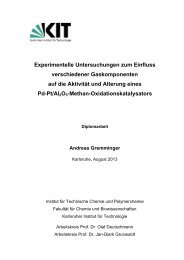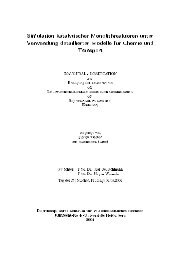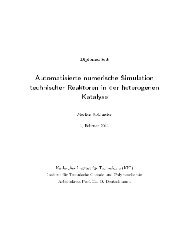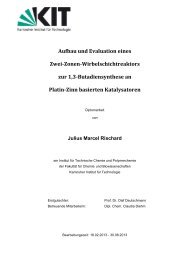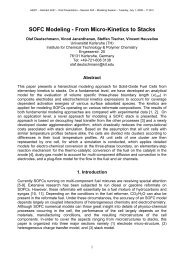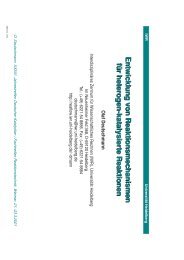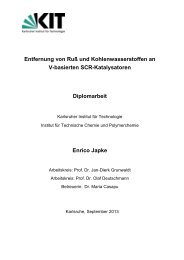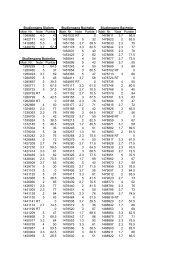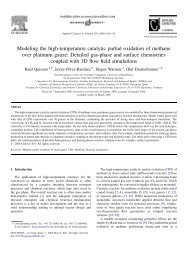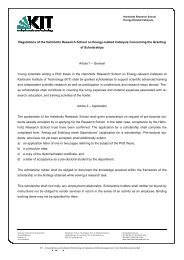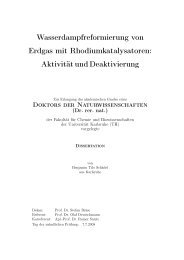Fuel Processing for Fuel Cells - Institut für Technische Chemie und ...
Fuel Processing for Fuel Cells - Institut für Technische Chemie und ...
Fuel Processing for Fuel Cells - Institut für Technische Chemie und ...
Create successful ePaper yourself
Turn your PDF publications into a flip-book with our unique Google optimized e-Paper software.
Author's personal copy<br />
50 Torsten Kaltschmitt and Olaf Deutschmann<br />
The Beretta group (Politecnico di Milano) has recently been able to<br />
show by a quartz capillary sampling technique that olefins are <strong>for</strong>med<br />
even in the initial catalyst section over a Rh/alumina catalysts in CPOX of<br />
propane (Donazzi et al., 2011), which clearly reveals that the application of<br />
two-zone model is risky. In these models, it is assumed that, in the first<br />
section of the catalyst, only catalytic conversion is significant, and then,<br />
further downstream, only gas-phase chemistry needs to be considered.<br />
In the experiment, the downstream part of the catalyst is coked-up;<br />
here, the Rh surface cannot act as a sink <strong>for</strong> radicals. The study also<br />
numerically simulated the coverage of the Rh catalyst as a function of<br />
the axial coordinate, revealing a sufficient number of unoccupied surface<br />
sites at lean (C/O¼0.8) conditions (Figure 15 (left)). At rich conditions<br />
(C/O ¼1.2; Figure 15 (right)), however, the surface further downstream is<br />
completely covered by carbon. This study (Hartmann et al., 2010) also<br />
revealed that the applied chemical models—even the most detailed ones<br />
available—need further improvement, in particular regarding the <strong>for</strong>mation<br />
of minor by-products at rich conditions.<br />
7.2 Predicting and controlling coking in fuel re<strong>for</strong>mers<br />
7.2.1 Catalyst deactivation due to coking<br />
The model discussed above predicts a surface completely covered by<br />
carbon, C(s), in the downstream section of the catalyst, z>1 mm. Since<br />
the model does not include direct interactions between gas-phase species<br />
and carbon on the surface, the gas-phase conversion practically proceeds<br />
Surface coverage<br />
1E+00<br />
Rh (s)<br />
1E+00<br />
1E-01<br />
CO (s)<br />
Rh (s)<br />
1E-01<br />
CO<br />
1E-02<br />
H (s)<br />
1E-02<br />
1E-03<br />
1E-03<br />
H O<br />
C (s)<br />
1E-04<br />
1E-04<br />
O (s)<br />
C<br />
1E-05<br />
1E-05<br />
OH (s)<br />
1E-06<br />
OH (s)<br />
1E-06<br />
1E-07<br />
H 2 O (s)<br />
1E-07<br />
H 2 O (s)<br />
1E-08<br />
1E-08 <strong>Fuel</strong>-rich conditions—enlarged<br />
1E-09<br />
1E-09<br />
CO 2 CO 2 (s)<br />
1E-10<br />
1E-10<br />
0.0 2.5 5.0 7.5 10.0<br />
0.0 0.3 0.5 0.8 1.0<br />
Axial position [mm]<br />
Axial position [mm]<br />
Figure 15 Numerically predicted surface coverage as a function of axial position along<br />
the honeycomb catalyst channel in CPOX of iso-octane over a Rh/alumina-coated<br />
monolith. Conditions: C/O¼0.8, 1359 K (left), C/O¼1.2, 1076 K (right); taken from<br />
Hartmann et al. (2010).<br />
Surface coverage



